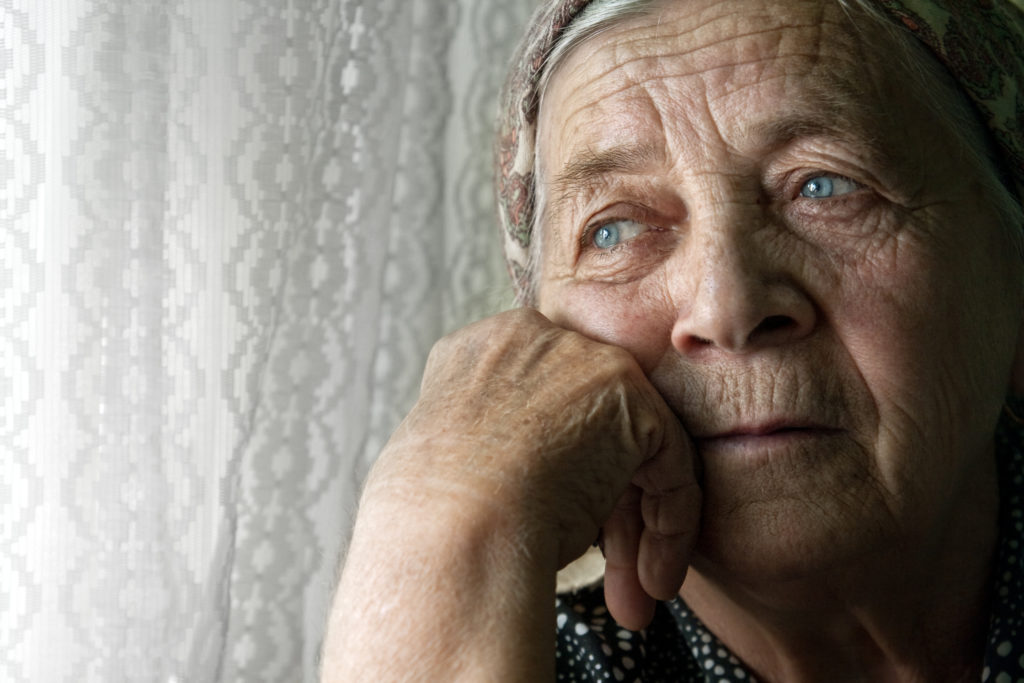
Depression is commonly seen with self-neglect
Definition
Self-neglect is difficult to describe because it has no accepted definition. A commonly used definition of self-neglect is self-care and/or living conditions that are potentially hazardous to the health, safety or well-being of adults (the National Adult Protective Services Association, n.d.a). For more information, see The Various Definitions of Self-Neglect.
Self-Neglect vs. Elder Abuse
Self-neglect is not only is self-neglect difficult to define, it is also difficult to categorize. In the past, self-neglect was categorized under elder-abuse. This is understandable as self-neglect is related to elder mistreatment (National Research Council, 2003) (Figure 1). Beginning in the early 2000s, experts began to agree that self-neglect should not be included as a form of elder abuse just as suicide is not considered a form of murder (Lachs & Pillemer, 2015).

Figure 1: Elder Mistreatment and Adjacent Domains of Research and Policy. When do harmful acts or omissions lie within the domain of elder mistreatment? A = core area of elder mistreatment Adjacent domains of research and policy interest: B = mistreatment of adults with disabilities C = “self-neglect” by elderly people; victimization by strangers D = spouse or intimate partner discord or violence involving an elderly partner (National Research Council, 2003, p. 43)
Currently, there are 5 forms of elder abuse. These include physical abuse, verbal or psychological abuse, sexual abuse, financial abuse, and neglect. Self-neglect is not considered to be a form of elder abuse. However, most states in the US still legally categorize self-neglect under elder abuse, probably because the laws have not been updated (State Definitions, Laws, and Processes). Moreover, historical data from APS often includes self-neglect under elder abuse (see Types of elder abuse for Cuyahoga County Department of Senior and Adult Services, 2013). This can be confusing for those first learning about self-neglect and elder abuse.
It is important to know that the term”mistreatment” is sometimes used instead of “abuse” to make it clear that self-neglect is being excluded. In other words, “elder mistreatment” excludes self-neglect and means that someone other than the elder individual has caused “some injury, deprivation, or dangerous condition” (National Research Council, 2003, p. 40).
Self-Neglect as a Syndrome
Researchers have argued for decades that self-neglect is a syndrome, a group of symptoms that consistently occur together (Reyes-Ortiz, Burnett, Flores, Halphen, & Dyer, 2014; Halliday, Banerjee, Philpot, & Macdonald, 2000; Macmillan & Shaw, 1966; Syndrome, n.d.). There are 5 symptoms that most researchers agree are usually seen with self-neglect: squalor, social withdrawal, apathy, hoarding, and lack of shame (Pavlou & Lachs, 2006; Lee & LoGiudice, 2012). In addition, substance abuse, dementia, and depression are often seen in self-neglect (National Committee for the Prevention of Elder Abuse, n.d.). However, there is no agreement on exactly what elements of these symptoms must be present to diagnose self-neglect. Ultimately, an expert must evaluate the individual to determine if self-neglect exists (Culo, 2011). For more information, see Most Important Characteristics of Self-Neglect Picture List.
Who is at Risk for Self-Neglect?
Self-neglect can occur at any age, but is most commonly seen is in the elderly, especially over 75 years of age (Lauder & Roxburgh, 2012). It also occurs in adults with disabilities. When self-neglect occurs with other diseases, it can create a cycle; as self-neglect worsens, it causes the other conditions to worsen as well. For more information, see History of Self-Neglect, Causes & Risk Factors, Hoarding, Depression, and Dementia .

Selfneglect.org is a free educational website
Ethical & Legal Aspects of Self-Neglect
Addressing self-neglect can be complicated. When an individual is of sound mind, he or she is allowed to act as they like, even when the behavior is harmful.(Day et al., 2016). There are two main exceptions: incompetency and self-neglecting behaviors that place others at risk of harm. Incompetency is when an individual has a poor ability to remember, reason, or understand the consequences of their actions (Competency and Incompetency, n.d.). Legally, it means that the person cannot make legally binding decisions (Ridings, 2008). Individuals with self-neglect are also not legally allowed to place others in danger. For example, if self-neglecting behaviors violate city housing codes or fire codes, officials may intervene and force the individual to make corrections. However, if individuals with self-neglect are competent and follow the law, they cannot be forced to change their behavior (autonomy) (Ridings, 2008). These concepts are more fully explored in the sections Ethics, Competency, International and US Federal Law, US State Law, Advance Directives and Guardianship.
Getting Involved
Despite all of these obstacles, loved-ones can still make a positive difference for those with self-neglect. Adult Protective Services (APS) is a state-run agency in all 50 states. APS helps the elderly and adults with disabilities by assessing each situation, then developing a plan to address his or her unique needs (NAPSA, n.d.b). Adult Protective Services reviews all reports of suspected self-neglect and investigates those that pass the screening process. Self-neglect accounts for almost half of cases reported to APS (Woolf, 1998). Those reporting self-neglect can choose to remain anonymous. Getting Involved, Worried About Reporting Self-Neglect, Adult Protective Services, Reporting Self-Neglect, What Happens Next, and Caregiving all have dedicated sections on Selfneglect.org.
ReferencesAmanullah, S., Oomman, S., & Datta, S. S. (2009). “Diogenes syndrome” revisited. The German Journal of Psychiatry, 12, 38-44.
Arizona Attorney General Mark Brnovich. (n.d.b). Elder abuse information and training guide. Retrieved from http://www.azag.gov/seniors/elder-abuse-information-and-training-guide#9
Boothroyd, K. (2014). Self-neglect is a growing and largely hidden problem. Retrieved on June 7, 2016 from http://www.asaging.org/blog/elder-self-neglect-growing-and-largely-hidden-problem
Brockway, L. H. (2009, June 19). Informed refusal: when patients decline treatment. Retrieved January 1, 2017 from https://www.tmlt.org/tmlt/tmlt-resources/newscenter/blog/2009/Informed-refusal.html
Clark, A. N. G., Mankikar, G. D., & Gray, I. (1975). Diogenes syndrome: A clinical study of gross neglect in old age. The Lancet, 305(7903), 366-368.
Competency and Incompetency. (n.d.). Competency and Incompetency. Retrieved on January 1, 2017 from http://www.peoples-law.org/files/guardian_ch2.pdf
Culo, S. (2011). Risk assessment and intervention for vulnerable older adults. British Columbia Medical Journal, 53(8), 421-425.
Day, M. R., Leahy-Warren, P., & McCarthy, G. (2016). Self-neglect: Ethical considerations. Annual Review of Nursing Research, 34(1), 89-107.
Halliday, G., Banerjee, S., Philpot, M., & Macdonald, A. (2000). Community study of people who live in squalor. The Lancet, 355(9207), 882-886.
Irvine, J. D., & Nwachukwu, K. (2014). Recognizing Diogenes syndrome: A case report. Bio Med Central Research Notes, 7(1), 276.
Lachs, M. S., & Pillemer, K. A. (2015). Elder abuse. New England Journal of Medicine, 373(20), 1947-1956.
Lauder, W., & Roxburgh, M. (2012). Self‐neglect consultation rates and comorbidities in primary care. International Journal of Nursing Practice, 18(5), 454-461.
Lee, S. M., & LoGiudice, D. (2012). Phenomenology of squalor, hoarding and self‐neglect: An Australian aged care perspective. Internal Medicine Journal, 42(1), 98-101.
Macmillan, D., & Shaw, P. (1966). Senile breakdown in standards of personal and environmental cleanliness. British Medical Journal, 2(5521), 1032–1037.
Mosqueda, L., & Dong, X. (2011). Elder abuse and self-neglect: “I don’t care anything about going to the doctor, to be honest….”. The Journal of the American Medical Association, 306(5), 532-540.
National Adult Protective Services Association. (n.d.a). Other safety concerns and self-neglect. Retrieved from http://www.napsa-now.org/get-informed/other-safety-concerns-2/
National Adult Protective Services Association. (n.d.b). What is Adult Protective Services? Retrieved from http://www.napsa-now.org/get-help/how-aps-helps/
National Committee for the Prevention of Elder Abuse. (n.d.). Neglect and self-neglect. Retrieved from http://www.preventelderabuse.org/elderabuse/neglect.html
National Research Council. (2003). Elder mistreatment: Abuse, neglect, and exploitation in an aging America. National Academies Press.
Pavlou, M. P., & Lachs, M. S. (2006). Could Self‐Neglect in Older Adults Be a Geriatric Syndrome?. Journal of the American Geriatrics Society, 54(5), 831-842.
Reyes-Ortiz, C. A., Burnett, J., Flores, D. V., Halphen, J. M., & Dyer, C. B. (2014). Medical implications of elder abuse: Self-neglect. Clinics in Geriatric Medicine, 30(4), 807-823.
Ridings, J. (2008). Using concept mapping to identify elder self-neglect program evaluation information for Metro Chicago. ProQuest.
Sharpless, B. A. (Ed.). (2016). Unusual and Rare Psychological Disorders: A Handbook for Clinical Practice and Research. Oxford University Press.
“Syndrome.” (n.d.). In Merriam-Webster.com. Retrieved January 4, 2017 from https://www.merriam-webster.com/dictionary/syndrome
World Health Organization. (2016). Classifications. Retrieved from http://www.who.int/classifications/en/
Woolf, L. M. (1998). Elder abuse and neglect. Retrieved from http://faculty.webster.edu/woolflm/abuse.html#neglect
Last updated: June 6, 2020 at 15:18 pm by
I. M. Abumaria, Doctor of Nursing Practice
Version 2.00